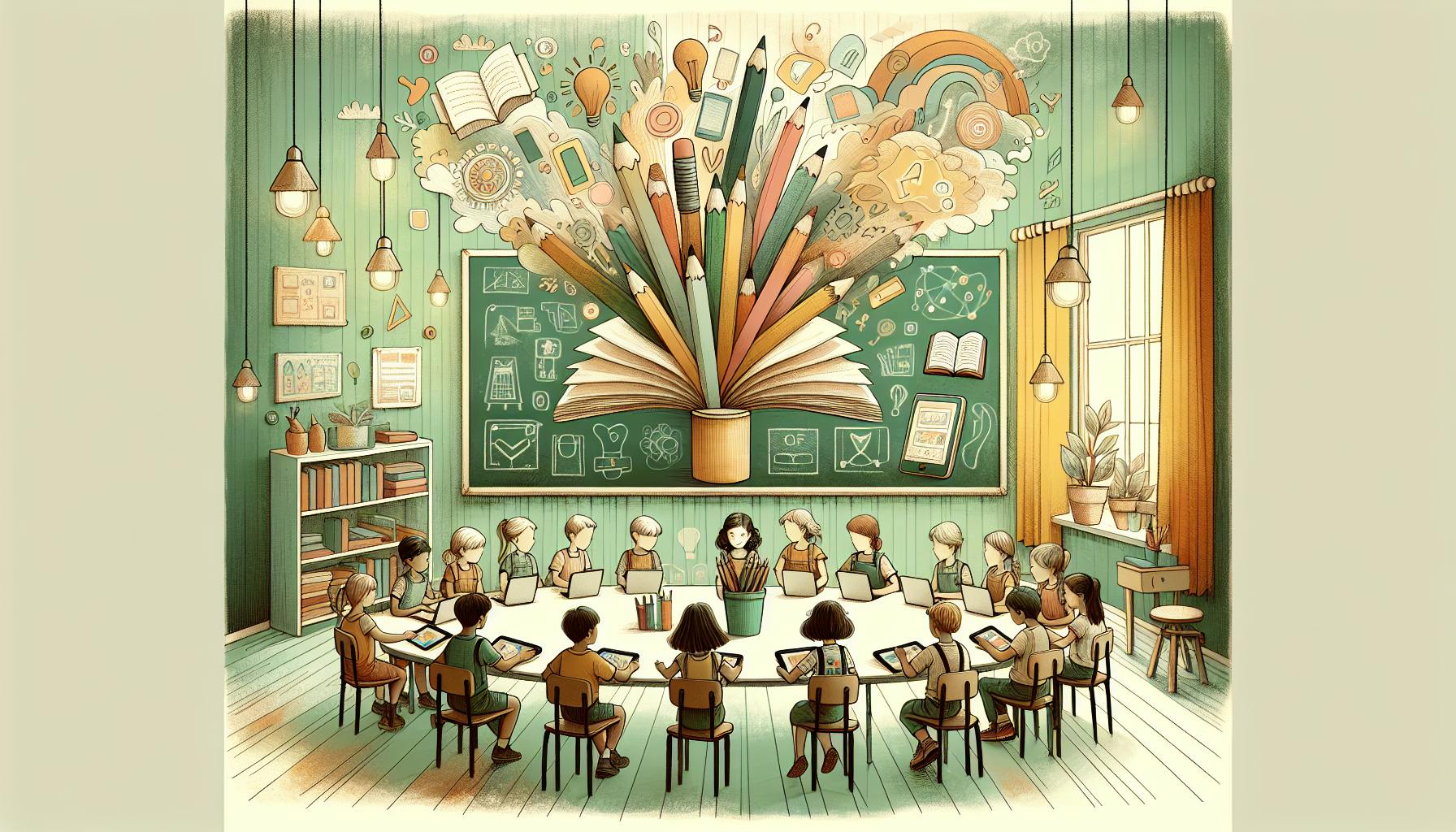Finding meaningful books for middle school students can be challenging.
However, The Giver offers thought-provoking themes relevant to adolescence while meeting curriculum standards.
This review for teachers explores the dystopian novel's plot, symbolism, and classroom activities to enrich comprehension and critical analysis.
Introduction to 'The Giver': A Book Review for Educators
'The Giver' by Lois Lowry is a thought-provoking dystopian novel that explores complex themes of memory, emotion, conformity, and free will. Set in a futuristic society devoid of pain, strife, or individual choice, the book provokes philosophical questions around the values of freedom, passion, and human connection. This makes it a profoundly relevant text for middle school students to analyze and debate.
As educators develop lesson plans and activities around 'The Giver', it can be helpful to consider reviews that provide guidance on effectively teaching the novel. This article offers insights and recommendations aimed specifically at English and Language Arts teachers.
Synopsis of 'The Giver's' Dystopian World
The Giver' depicts a highly-regulated world where emotional range and individual passions have been eradicated in favor of order and efficiency. Citizens follow strict rules dictating every aspect their lives. 12-year-old Jonas is selected to become the next 'Receiver of Memory', taking on memories of deep emotion and pain from the current receiver. As Jonas undergoes his training, he begins to question the supposed utopia he lives in.
The novel prompts examinations around themes of conformity versus individuality, security versus freedom, and the values of emotional bonds. These philosophical debates make it well-suited to class discussions.
Relevance to Middle School Curriculum
'The Giver' aligns well with middle school English Language Arts standards on analyzing theme, understanding figurative language, comparing dystopian visions, and more. The text prompts critical thinking on perspectives around societal norms, individual choice, and human nature.
As students explore complex questions the novel raises, they build literacy skills in drawing text evidence, identifying author's purpose, and articulating their own interpretations. This develops critical reading, writing, and discussion abilities that serve them throughout their education.
Resource Compilation: Printables, Games, and Task Cards
To enrich students' reading experience, teachers may utilize accompanying resources like:
- Vocabulary printables to reinforce new word meanings
- Character analysis activities to deepen comprehension
- Prediction games to actively engage with the storyline
- Task cards on plot points and themes to check understanding
These supplementary materials help cement students' literary knowledge while keeping them engaged with interactive elements. They also provide opportunities to incorporate digital tools and learning games into the reading experience.
Compiling relevant printables, multimedia activities, and creative assignments can profoundly shape how students connect with and retain the important themes in 'The Giver'. Equipping educators with reviews on how best to teach this impactful novel supports deeper literacy development.
Is The Giver appropriate for 7th grade?
The Giver is a popular book that is often taught in 7th grade or middle school English and reading classes. However, the themes and content may not be suitable for all 11-13 year old students.
Here are some key considerations regarding The Giver's appropriateness for 7th graders:
- The book deals with complex themes like euthanasia, suicide, totalitarian governments, and the loss of individuality and emotion that some students may find disturbing or confusing. There are also references to starvation, war, and lethal injections.
- There are scenes involving drug use/injections and allusions to sexual stirrings that some parents or schools may deem inappropriate for younger teens and pre-teens.
- The book has been occasionally banned or challenged for its treatment of controversial issues. As such, it requires maturity to understand the underlying messages about the importance of individual freedoms.
- Most 7th graders have the reading comprehension skills to understand the plot and themes. However, the suitability depends on the individual student's maturity level.
- Many schools successfully teach The Giver to 7th graders, but often provide guidance to help students process the complex ideas. Some teachers pre-screen the novel before assigning it.
In summary, The Giver can be appropriate for mature 7th grade readers when taught with care to promote understanding. But some 7th graders may lack the emotional readiness. As such, teachers should evaluate the novel's suitability on a case-by-case basis.
Is The Giver appropriate for 5th grade?
The Giver is often considered an appropriate novel for 5th grade or middle school students. Here are some key points to consider regarding its suitability:
Reading Level
- The Giver has a Lexile score between 760L-900L, making it suitable for competent 5th grade readers. Struggling readers may find some vocabulary challenging.
- The concepts explored require some maturity to fully grasp, but the reading level itself is generally manageable for 5th graders.
Themes and Content
- The Giver deals with complex themes like conformity vs. individuality, personal freedom vs. social stability, emotion vs. rationality, etc. This encourages critical thinking.
- There is some violence and disturbing imagery that may be emotionally intense for more sensitive students. Teachers should preview and provide guidance.
- There are no graphic scenes, making the novel generally age-appropriate. Difficult concepts can lead to thoughtful discussions.
Benefits
- The Giver encourages students to challenge assumptions and think deeply about society's rules. Great for class debates.
- It exposes students to the dystopian fiction genre and creative world-building.
Overall, with proper scaffolding by the teacher, The Giver can be an enriching novel study for mature 5th graders. The reading level is mostly reasonable, but the ideas require guidance to fully digest. It sparks important conversations about individuality and morality.
What lessons does The Giver teach?
The Giver teaches several powerful lessons that are relevant for teachers and students alike. Here are some of the key takeaways:
The Importance of Memory and History
One of the most central themes in The Giver is the value of memory and history. In Jonas' community, the past has been erased and the people have lost their memories. This allows them to live in a peaceful but colorless world. As Jonas receives memories from The Giver, he comes to understand the richness and wisdom that the past provides. This highlights why memory and history are so vital - they connect us to previous generations, inform our present, and guide our future. Teachers can discuss with students why memory matters and how we can learn from history.
The Role of Emotion
By eliminating emotional extremes, Jonas' community has also dampened emotional depth and meaning. Jonas only begins to understand the power of feelings as he receives memories from The Giver and experiences real joy, pain, and love for the first time. This emotional awareness transforms Jonas entirely. Teachers can explore with students the essential role our emotions play in shaping who we are as human beings. Although emotions can be difficult, they give life meaning and color.
The Value of Individuality and Freedom
Jonas realizes that without choice and individuality, life loses its vibrancy. His community's decision to do away with differences for the sake of "sameness" robs its citizens of their humanity. The value of freedom - even to make mistakes - becomes clear. Teachers can discuss with students the dangers of forced conformity and why liberty, diversity and respect for individuality are so precious.
The Balance between Security and Fulfillment
Finally, Jonas' community has traded feeling, freedom, and fulfillment for comfort and security. Their lives are safe but empty. As Jonas discovers the frustrations of choice and emotion, he learns you cannot have one without the other. Teachers can explore with students why this tradeoff is flawed, and how we can strive for both security and meaning in life.
The Giver prompts profound reflection about memory, emotion, conformity, freedom and purpose - topics very relevant for middle school classrooms. Teachers can stimulate wonderful discussions by sharing its lessons.
sbb-itb-bb2be89
What grade should students read The Giver?
The Giver by Lois Lowry has a Lexile measure of 760L, making it best suited for students in grades 6-8. At these grade levels, students should be reading texts with Lexile levels ranging from 925L to 1185L to ensure they are on track to be college and career ready by the end of 12th grade.
Here is some additional context around The Giver's reading level and appropriate grade placement:
- The book's themes around conformity, identity, and morality suit the emotional and intellectual maturity typical of middle school students.
- Many school districts place The Giver on 6th-8th grade reading lists as it matches well with state standards for English language arts at those grade levels.
- While some advanced 5th grade readers may be able to comprehend The Giver, the book's more complex themes are best explored with guided discussion in 6th-8th grade.
So in summary, The Giver is an impactful novel that engages students in grades 6-8 with its thought-provoking ideas and narrative style. By reading texts at or above its 760L Lexile level, students will continue building literacy skills to prepare them for high school and beyond.
Lesson Planning for 'The Giver'
Engaging Pre-Reading Strategies
Here are some ideas to introduce key themes and context before reading "The Giver":
- Have students create "before we read" mind maps showing their current knowledge, questions, and predictions about the novel's themes like individuality, rules/laws, and memory. Revisit the maps after reading to see how their understanding has developed.
- Show images depicting "utopian" communities and dystopian elements and have students categorize which they think "The Giver" will contain. Discuss why perfect societies often have dark elements in literature.
- Do a values continuum activity where students physically line up based on how much they agree/disagree with controversial statements tied to themes in the novel like "Rules are more important than choice" or "It's good to not feel emotional pain." Have students debate from their spot on the continuum.
Guided Reading and Novel Study Schedules
Break reading "The Giver" into sections. For each:
- Provide guided reading questions to check comprehension and predictions.
- Have reading checkpoints where small groups convene to summarize the section's key events and themes.
- Use journals, discussion circles, or Socratic seminars for reflection. Set goals for speaking times to ensure all voices are heard.
- To track understanding, have students create plot diagrams, character maps, or timelines noting important developments in the community and Jonas' transformation.
Vocabulary Enhancement and Figurative Language Review
To teach "The Giver's" complex vocabulary:
- Have students highlight unfamiliar words and idioms while reading, infer meanings from context clues, and define using dictionaries/glossaries.
- Create a word wall with terms like "release", "newchild", and "stirrings" and discuss how the community redefines common vocabulary.
- Review examples of figurative language like metaphors, allusions, and imagery tied to motifs like snow, ash, and sunburn. Have students draw visual representations.
- Allow collaborative glossary building so terms can be shared, discussed in groups, and mastered.
Post-Reading Activities and Discussion
Synthesize reading "The Giver" by:
- Hosting formal debates on issues the novel surfaces like freedom vs. safety, or emotion vs. practicality.
- Analyzing symbols and motifs by creating artistic projects showcasing how elements like color and the sled develop meaning.
- Researching real world examples of utopian experiments that succeeded for a time but crumbled. Discuss takeaways.
- Assigning reflective essays asking students to agree/disagree: "Jonas was right to leave his community." Use text evidence to support.
Interactive Classroom Activities for 'The Giver'
Teachers can utilize a variety of interactive and collaborative activities to engage students when teaching the novel 'The Giver' in their English/Language Arts classes.
Interactive Whiteboard Lessons
Interactive whiteboards allow teachers to create visually compelling and participatory lessons around 'The Giver'. Some ideas include:
- Creating a storyboard activity where students sequence important plot events from the novel on the board. This helps reinforce comprehension.
- Using the whiteboard annotation tools to visually highlight and analyze important passages from the text. Students can participate by annotating the passages together.
- Designing drag-and-drop vocabulary review games with words from the novel to reinforce learning.
- Displaying provocative discussion questions on the whiteboard and having students respond using the annotation tools. Get the entire class involved.
Independent Work Packet Ideas
Independent work packets allow students to explore concepts from 'The Giver' at their own pace. Teachers can include:
- Reading comprehension questions for each chapter that check for understanding.
- Thematic analysis prompts that have students trace motifs through the text.
- Creative writing prompts that have students put themselves in scenes or rewrite events.
- Vocabulary and reading strategy focused activities that reinforce reading skills.
Group Games and Collaborative Learning
Games build engagement and give students a fun, interactive way to learn collaboratively.
- Host a plot sequence speed quiz with teams.
- Play quote identification bingo by reading passages out loud.
- Break students into groups to compete in a symbolism scavenger hunt using the text.
Novel Study Review Activities
Ensure concepts stick by end-of-unit review activities:
- Have students make theme-based posters in small groups then present to class.
- Play a plot sequence game using storyboard templates.
- Write a final essay analyzing the novel's key symbols and motifs.
Assessment and Test Preparation for 'The Giver'
Formative Assessment Techniques
Formative assessments allow teachers to gauge student comprehension and engagement with "The Giver" on an ongoing basis. Some techniques include:
- Exit tickets: At the end of each reading session or class discussion, have students respond to a short prompt or question about key events, themes, or characters. Review responses to identify areas of confusion.
- Reading comprehension quizzes: Short multiple choice or short answer quizzes covering the latest reading assignment can reveal gaps in understanding.
- Literature circles: Break students into small groups to discuss each reading assignment. Have them share insights and questions. Listen in to identify struggles.
- Double entry journals: Have students record passages from the text alongside their personal reactions and commentary. Review entries to see their level of analysis.
Summative Assessment and Final Exam Creation
Summative assessments evaluate student learning at the conclusion of a unit. For "The Giver", final projects could include:
- Essays analyzing major themes, the development of Jonas's character, or the pros/cons of Sameness. Provide a bank of essay questions for students to choose from.
- Creative projects like designing a new cover for the book, writing an additional chapter, or adapting scenes into comics or storyboards. Outline clear grading criteria in a rubric.
- Oral presentations about the defining moments in Jonas's journey, with visual aids like timelines or character maps. Establish expectations for content and public speaking skills.
Study Guide Development and Test-Taking Strategies
Craft study guides summarizing plot details, vocabulary words, and discussion questions grouped by chapter. Teach students how to:
- Identify and analyze story elements like setting, conflict, and resolution
- Make predictions and connections between events
- Annotate important passages and take notes on new concepts
- Review materials frequently and quiz themselves to improve recall
Rubrics for Objective Grading
Develop project grading rubrics that outline expectations for:
- Comprehension of plot and themes
- Quality of analysis and interpretation
- Inclusion of specific story elements and examples from the text
- Creativity and effort
Use rubrics to grade student work consistently across all assessment formats - papers, projects, presentations, etc. Provide rubrics alongside assignment instructions so students understand grading criteria.
Conclusion: Reflecting on 'The Giver' in the Classroom
The Giver is a thought-provoking novel that offers many opportunities for discussion and reflection in the classroom. Here are some key takeaways when using the book as a teaching tool:
Fostering Empathy and Perspective-Taking
- The novel explores complex themes like empathy, conformity, and individuality that students can analyze and debate. It's a chance to cultivate perspective-taking and appreciate different viewpoints.
Exploring Utopian and Dystopian Societies
- Teachers can prompt students to compare and contrast the society in The Giver to real-world governments. This allows an analysis of the pros and cons of Sameness and the values that uphold communities.
Building Critical Thinking Skills
- The ambiguous ending leaves room for interpretation and independent thinking. Students must gather clues and evidence to craft their own theories about what happens after the final chapter.
Inspiring Creative Assignments
- From essays to art projects, The Giver sparks imaginative work. For example, students can write a new final chapter or paint their visualization of the mysterious Elsewhere.
The Giver and its complex themes open doors to impactful learning experiences. With the right resources, teachers can engage students in meaningful discussions and activities long after the final page.


